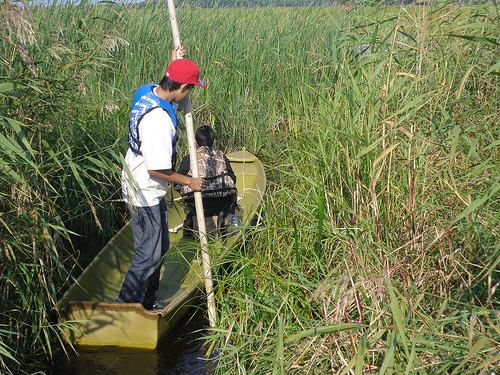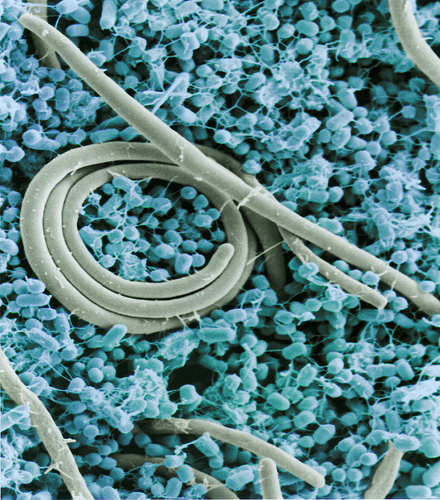
Grass and cotton fields in the Texas High Plains study. Credit: Vivien Allen (Texas Tech University).
This post is part of the Science Tuesday feature series on the USDA blog. Check back each week as we showcase stories and news from USDA’s rich science and research profile.
Words like eco-friendly, green, fair, climate-friendly, community-based and organic are popping up daily – in the news, in ads and labels, and in conversations ranging from kitchen tables to international conferences. All of these and more come under the umbrella of sustainability, which people often describe as caring for people, planet and proceeds all at the same time. Read more »

American Indian youth ricing. The Leech Lake Band of Ojibwe rely on water to preserve their culture, their agriculture and their overall quality of life
When Leech Lake Band of Ojibwe water resource professionals discovered that 60 percent of the Minnesota reservation’s septic systems were sub-standard or failing, they feared for the reservation’s health, indigenous rice fields, and fish populations.
Shirley Nordrum, a Leech Lake Extension educator with the University of Minnesota, responded with an extensive education program. She explains to homeowners how having the sanitation department pump their septic systems could protect their health and contribute to the safety of the environment and their community. She uses funds from U.S. Department of Agriculture’s (USDA) Federal Recognized Tribes Extension Program (FRTEP) to conduct this outreach effort. Her program has become a model for other communities. Read more »
Today, President Obama and I continue doing all we can to help farmers and ranchers impacted by the drought. As Congress comes back to Washington in September we will continue to encourage passage of a Food, Farm and Jobs Bill as soon as possible – to give USDA tools to help those who have been impacted by drought, while giving more certainty for farmers and ranchers.
While the drought has taken a toll on agriculture this year, we also know that America’s history of agricultural innovation and research advancement means farmers and ranchers are better-prepared than ever before to mitigate its effects.
USDA scientists and research partners have helped to provide these important new tools for decades – and their work continues today. Read more »

Colorized SEM (scanning electron micrograph) of the foodborne pathogen Salmonella enteritidis. Photo by Jean Guard, ARS.
This post is part of the Science Tuesday feature series on the USDA blog. Check back each week as we showcase stories and news from USDA’s rich science and research profile.
When it comes to microorganisms that contaminate our foods, you may think it’s a veritable jungle out there—but in fact, in the United States, most of the illnesses, hospitalizations and deaths caused by foodborne pathogens come down to 14 bad players. Read more »

USDA’s Economic Research Service estimates the availability of hundreds of commodities for human consumption. The Food Availability (Per Capita) Data System includes historical as well as recent data. (Photo courtesy of Shutterstock)
True or false?
- Since 1985, the amount of rice available for Americans to eat has nearly doubled, from 11.6 to 21.2 pounds per person in 2010.
- In 2010, pineapples were America’s favorite canned fruit, and tomatoes were our favorite canned vegetable.
- U.S. milk availability, which peaked at 44.7 gallons per person in 1945, was 20.1 gallons per person in 2010.
Answers (all true) can be found in the Economic Research Service’s Food Availability (Per Capita) Data System—a unique data set revealing the types and amounts of food commodities available for U.S. consumers to eat. Read more »
It’s been a productive time here in Qingdao, China. USDA and China’s Ministry of Science and Technology (MOST), with support from the Gates Foundation, have gathered some of the top minds from around the world at the Mini-Summit on Agricultural Research to discuss challenges related to food security, food safety, and sustainable agriculture. China’s Vice Minister for Science and Technology, Zhang Laiwu and I led talks among experts from many nations and many sectors to focus on strengthening international research collaboration to benefit our nations and agriculture around the world. Representatives of organizations like the Gates Foundation joined forces with African research leaders, the Food and Agriculture Organization and the World Bank to share information and discuss ways to leverage global resources to address global challenges affecting all nations.
The USDA and China’s MOST have a history of working together, with mutual respect, and with each meeting the relationship between our agencies grow stronger. USDA’s vision to address our shared challenges in the developed and developing world alike includes cooperative multilateral and international efforts. Through these efforts, we hope to further establish global research collaboration platforms which provide the building blocks for the scientific community to confront many of our most pressing challenges. These platforms include: Read more »




